Toshiba OCZ RD400 Review (512GB)
August 18, 2016 | 11:46
Companies: #ocz #ocz-storage-solutions #toshiba

Performance Analysis
The Toshiba OCZ RD400 offers excellent out-of-the-box performance. Sequential read speed with a low queue depth isn't quite as fast as the comparison Samsung drive's but raising it to four concurrent users, intimating reasonable load, produces a heady 2,738MB/s, which is as good as it gets, handily thrashing the Intel SSD 750 Series 1.2TB and gaining a significant lead over the Samsung SSD 950 Pro of an equivalent capacity. Write speed is also good, matching what we see from Samsung.Random read performance isn't so sharp, mind, but it picks up the pace in the write tests. And it seems as if the OCZ RD400 needs to have a medium queue depth to get the best out of the TC58 controller.
PCMark 8 is typical of the workloads used by most people on a single PC. Here, as expected, the OCZ RD400 scores well, though there isn't much to separate a great drive from a mediocre one. Of more importance for a drive of this calibre, we feel, is how well the SSD is able to cope with benchmarks once in a steady-state environment. Here, the performance is in line with the SSD 950 Pro in the first two Iometer tests but is compromised somewhat by significantly higher standard deviation than we expected to see, i.e. its consistency is not as strong.
Adding a mixture of reads and writes leads to, well, mixed performance, as the OCZ RD400 trails the SSD 950 Pro by a healthy degree in all but one of the tests. Of course, performance is very much scenario-specific, meaning running a particular test may play to the OCZ RD400's strengths more than other drives'.
Conclusion
Toshiba OCZ has shown that it has the wherewithal to create a premium PCI-E NVMe drive for the well-heeled enthusiast. Exceedingly fast in a straight line and producing solid numbers when in a used, consistent state, its introduction means that Samsung, and to a lesser extent Intel, doesn't have it all its way in this niche, high-end part of the SSD market.Throwing off the long-imposed shackles of SATA allows PC storage to be a first-class citizen for a cutting-edge PC. Baseline SSD performance has come on so far that the jump from SATA AHCI to full-blown NVMe PCI-E isn't going to feel like the quantum leap that transitioning from HDD to SDD was, but it is clear that drives such as the Toshiba OCZ RD400 will become the de facto performance standard for the discerning builder. For those of you who automatically gravitated to Samsung due a lack of choice, the OCZ RD400, backed by a comprehensive warranty, is a welcome breath of fresh air.
While the OCZ RD400 carries some advantages over Samsung - the only real competitor at the moment for M.2 NVMe drives - such as the better warranty conditions, the bigger range of capacities and the availability of the drive with and without a PCI-E AIC adaptor, none of these are true killer features. 256GB tends to be the minimum SSD size we recommend, though it's true that if you do need the speed of an M.2 NVMe drive and aren't overly fussed about capacity or are on a budget, the 128GB OCZ RD400 is probably your best bet since competing Samsung products are OEM only and lack the five-year warranty of the consumer SSD 950 Pro. As to the 1TB version, Samsung does have the OEM SM961 now, but the OCZ RD400 is again the only consumer-grade option for now - it's more expensive as a result, but not dreadfully so, starting at around £580 compared to £530 for Samsung's.
The PCI-E adaptor is nice in that it allows for greater compatibility out-of-the-box, but it's easy to source and buy M.2 AIC adaptors yourself. Granted, these often come without any cooling, but equally the single thermal pad on the OCZ adaptor is hardly the most advanced cooling solution. For the 512GB, even if you really shop around the AIC version seems to be pretty much impossible to find in stock in the UK and, if you do find it, not well priced relative to the non-AIC version. This is likely just a temporary stocking issue, but it's a shame given that that's the exact SKU we have for review.
The SSD 950 Pro has a lead in performance terms in most instances, but real-world differences will be hard to feel. In the UK market the two 512GB M.2 drives are currently matched on pricing too. Ultimately, there's really not a great deal between them, but it's a relief to see someone finally bringing a respectable fight to Samsung, and each of the OCZ RD400 models is certainly worth a closer look depending on your specific needs.


MSI MPG Velox 100R Chassis Review
October 14 2021 | 15:04

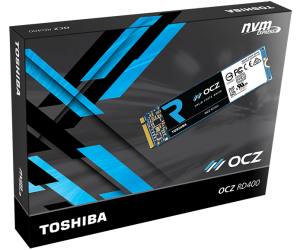
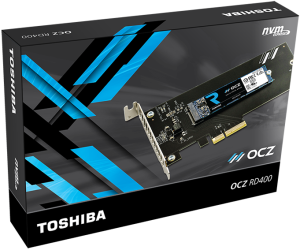
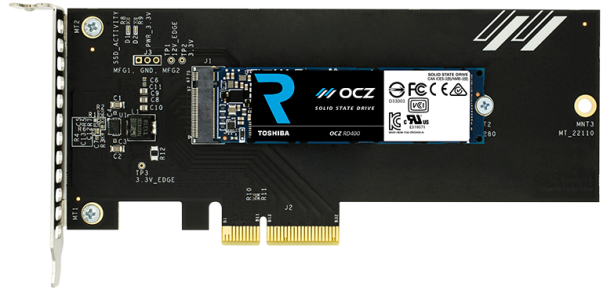
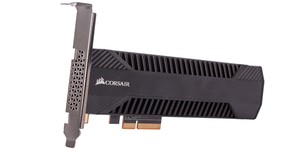
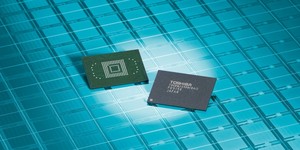





Want to comment? Please log in.